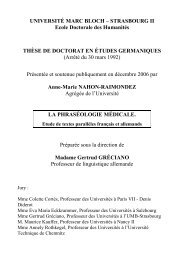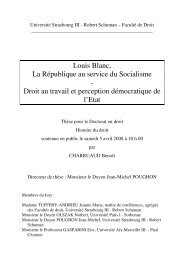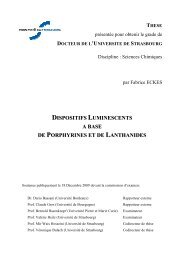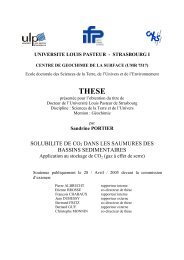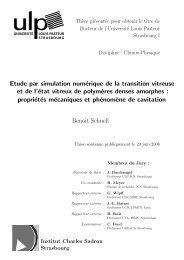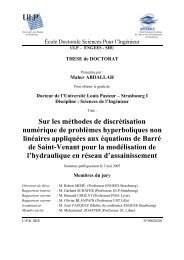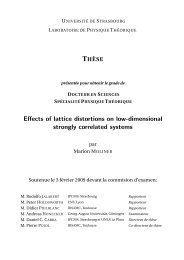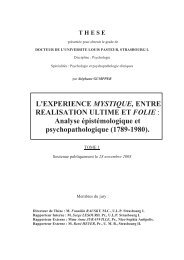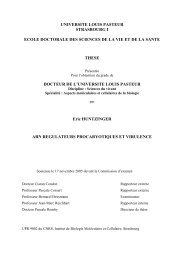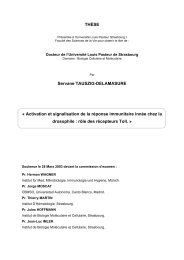Économie Évolutionniste et Culture d'Entreprise
Économie Évolutionniste et Culture d'Entreprise
Économie Évolutionniste et Culture d'Entreprise
Create successful ePaper yourself
Turn your PDF publications into a flip-book with our unique Google optimized e-Paper software.
KNUDSEN, T. (2000a). « Linking Comp<strong>et</strong>itive Selection and the Linking Comp<strong>et</strong>itive Selection and The<br />
Evolution of Team-Embodied Skills », Prepared for “Druid’s summer conference on the learning<br />
economy, firms, regions and Nation specific institutions”, Rebild- June 15-17.<br />
——— (2000b). « Why Tacit Knowledge Protects the Firm’s Evolutionary Potential (and Why<br />
Codification Doesn’t) », prepared for the workshop « Cognition and Evolution in the Theory of the<br />
Firm », Copenhagen Business School, 25-27 September.<br />
——— (2001). « The Evolutionary Significance of Tacit Knowledge », Presented at DRUID’s Nelson &<br />
Winter Conference, June 2001.<br />
KOGUT, B. <strong>et</strong> ZANDER U. (1992). « Knowledge of the Firm, Combinative Capabilities, and the Replication<br />
of Technology », Organization Science, vol. 3, no. 3, p. 383-397.<br />
KOPPL, R. <strong>et</strong> LANGLOIS R.N. (2001). « Organizations and Language Games », Journal of Management<br />
and Governance, vol. 5, no. 3-4, p. 287-305.<br />
KREPS, D. (1990). « Corporate <strong>Culture</strong> and Economic Theory », in J. Alt and K. Shepsle (Eds.),<br />
Perspectives on Positive Political Economy, New York: Cambridge University Press, p. 90-143.<br />
LAGUEUX, M. (1999). « Do M<strong>et</strong>aphors Affect Economic Theory? », Economics and Philosophy, vol. 15,<br />
p. 1-22.<br />
LALAND, K.N. <strong>et</strong> BROWN G.R. (2002). Sense and Nonsense : Evolutionary Perspectives on Human<br />
Behaviour, Oxford and New York: Oxford University Press.<br />
LAMARCK, J.-B. (1801). Système des animaux sans vertèbres, Paris: Chez D<strong>et</strong>erville.<br />
LANGLOIS, R.N. (1993). « Capabilities and Coherence in Firms and Mark<strong>et</strong>s », Paper for the Conference<br />
on Evolutionary and Resource-based Approaches to Strategy, Copenhagen, August 27-29.<br />
——— (1997). « La firme planifie-t-elle ? », in P. Garrouste (Ed.), Les frontières de la firme, Paris :<br />
Economica, p. 61-80.<br />
——— (2002). « Modularity in Technology and Organization », Journal of Economic Behavior and<br />
Organization, vol. 49, no. 1, p. 19-37.<br />
LANGLOIS, R.N. <strong>et</strong> ROBERTSON P.L. (1993). « Business Organization as a Coordination Problem: Toward<br />
A Dynamic Theory of the Boundaries of the Firm », Business and Economic History, vol. 22, no. 1,<br />
p. 31-41.<br />
LANGLOIS, R.N. <strong>et</strong> FOSS N. (1996). « Capabilities and Governance: The rebirth of Production in the<br />
Theory of Economic Organization », Kyklos, vol. 52, no. 2, p. 201-218.<br />
LAVE, J. <strong>et</strong> WENGER E.C. (1991). Situated Learning: Legitimate Peripheral Participation, New York:<br />
Cambridge University Press.<br />
LATOUR, B. (1999). « Pourquoi viens-tu si Tarde ? », La Recherche, vol. 320, 05.



